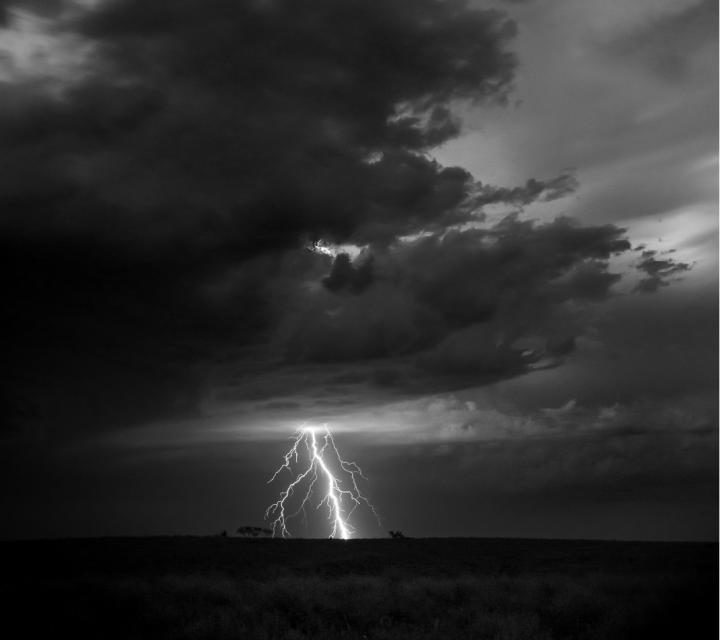Image: Thunderstorms in the Soiuthern Great Plains [= the southern Great Plains]. more. Photo: Chris Maupin / Texas A&M University
Research News from TEXAS A&M UNIVERSITY
Using isotopes from Texas cave stalactites, scientists at Texas A&M’s College of Geosciences studied the changes in thunderstorms in the southern Great Plains.
Large thunderstorms in the southern Great Plains of the USA are among the strongest on earth. In recent years, these storms have increased in frequency and intensity, and new research shows that these shifts are related to climate varia fluctuations.
The results obtained by Christopher Maupin, Courtney Schumacher and Brendan Roark, as well as all scientists at the College of Geosciences at Texas A&M University, were recently published in Nature Geoscience.
In the study, the researchers analyzed oxygen isotopes from 30,000-50,000-year-old stalactites from Texas caves in order to understand trends regarding thunderstorms in the past and their duration. They discovered that the shift of thunderstorm regimes from weak to strongly organized on millennial time scales coincides with known global abrupt climate shifts during the last ice age, which took place from 120,000 to 11,500 years ago.
Through a recent synoptic analysis, the researchers realized that thunderstorms in the southern Great Plains are strongly related to changes in wind and humidity patterns that occur on a much larger scale. Understanding these changes and various correlations will not only help to reconstruct past thunderstorm events, but also to predict future thunderstorm patterns in the mid-latitudes.
„Proxy data is available in caves in the southern Great Plains,“ Maupin said. „There are probably thousands of caves in the southern Great Plains and in South Texas. Why has more research not been done in these areas? Cave deposits are just as promising as proxies.“
Schumacher said that scientists understand today’s precipitation patterns and that large storms can reduce the number of isotopes formed.
„However, we don’t know what will happen in the future, and this work will help predict trends of storms in the future,“ she said. „If we create a climate model for the past that matches the cave records and run the same model in the future, we can trust the results more if they match the cave records than if they don’t. If one of two models really matches the cave isotopes, then this model can be trusted when it comes to understanding the storm distribution in the future.“
Climate records hidden in caves are far too little known.
Maupin, a paleoclimatologist, described the limitations of capturing the true distribution of weather events over time.
„There are really important questions about what has happened in the past in terms of major weather events that we get through mesoscale convective systems (large storms) versus non-mesoscale (smaller storms) thunderstorms,“ Maupin said. „There are really extraordinary amounts of rain, and the grid of the model is too coarse-meshed to properly capture these events. Paleoclimatology helps to understand past events in order to develop ideas about how they react to the middle climate.“
Maupin worked with National Taiwan University to perform uranium-thorium dating and discovered that the stalactites and stalagmites actually date back to the Ice Age.
Interdisciplinary cooperation
Schumacher’s expertise was needed to establish correlations with various precipitation events that occurred over time. She had experience working with radar data and rain measurements on a global scale.
„Major storms covering hundreds of miles provide about 50-80% of the rain in Texas,“ Schumacher said. „In this day and age, these storms have different isotope signatures.“
Maupin’s research draws on outdated principles in the paleo-world because it is necessary to investigate why storms* are getting stronger and what affects them, he said.
[By „storms“ here always mean thunderstorms. The term „storm“ has a much broader meaning in American than the direct German translation with „Sturm“. for example. If a large continuous rain event is called a „rainstorm“ even if no wind has occurred at all. A. d. Übers.]
„These thunderstorms are so large that even if most of the rain falls in Oklahoma, the rain in Texas still carries the isotopic signature of these huge storms,“ Maupin explained. „You take a fingerprint from these systems no matter where they occur, and they don’t have to be super localized to be detected. Large storms cause impoverished isotope signatures. The variability in stalactites cannot be explained by temperature changes alone.“
…
Translated by Christian Freuer for EIKE






zum Thema passend:
https://www.focus.de/panorama/wetter-aktuell/wetter-in-deutschland-alarmstufe-rot-in-4-regionen-hier-drohen-jetzt-schwere-gewitter-mit-heftigem-starkregen_id_13069089.html
Extreme Hitze in Kanada: Dutzende Tote bei fast 50 Grad Celsius
08.50 Uhr: Die anhaltende Hitzewelle im Westen Kanadas hat für neue Höchsttemperaturen gesorgt und zu mehreren Todesfällen beigetragen. 49,5 Grad Celsius zeigte das Thermometer am Dienstag in Lytton (Provinz British Columbia) an, wie die örtliche Wetterbehörde auf Twitter mitteilte. Das sei ein „Allzeit-Temperaturrekord“.
Berichtet werden 46.1 deg C hier
Oder 116 F (46.7 Deg C) hier.
Hier sind die Temperaturen stuendlich angezeigt. Heute noch gucke weil morgen eventuell nicht mehr so da!
Demnach kann es auch ein Fehler der Apperatur sein, da keine Kondition angegeben ist.
Die Arbeit bezieht sich auf die südlichen Great Plains der USA. Daraus kann man nicht folgern, dass Gewitter global zugenommen haben. Ich habe ein Bild von NASA gefunden, das die globale Häufigkeit von Gewittern zeigt. Da das Bild aus dem Jahr 2004 stammt ist anzunehmen, dass die globale Häufigkeit nicht signifikant angestiegen ist.